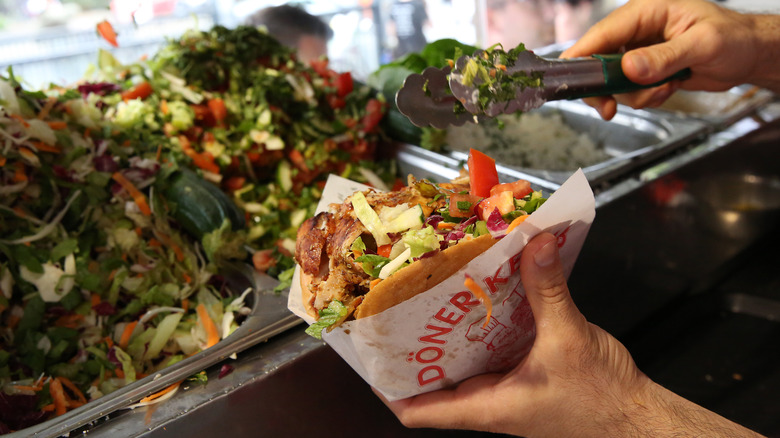The Affordable, Ubiquitous Food Rick Steves Recommends Trying Wherever You Travel
Rick Steves is a national treasure. His PBS travel shows aren't all about him showing off the latest luxury destinations that he can afford and we can't — instead, they're targeted at the average tourist, while still warning us away from the average tourist traps. Among the useful pieces of advice we've learned from this travel pro are not to order French onion soup in summer, to steer clear of restaurants boasting "no frozen food" (their need to proclaim this makes the assertion dubious), and not to pay the upcharge for a European hotel breakfast. He also has a list of "dos," with one hot tip for budget gourmets being to seek out kebabs wherever you may find them.
Kebabs are a type of cheap eats that are pretty ubiquitous throughout Europe. Doner kebabs are Turkish in origin, and Turkey, like Russia and Kazakhstan, is located partly in Europe and partly in Asia. Turkish guestworkers, or gastarbeiters, as they're known in Germany, have spread throughout Western Europe over the past six decades, and in so doing, have greatly enriched the culinary offerings in each country.
Steves has enjoyed kebabs in France, Germany, and Italy, while my son speaks highly of the ones he's eaten in Warsaw. (He prefers them to pierogis, even if his Polish wife isn't entirely on board with this heresy.) Kebabs are also enormously popular in the U.K. and Scandinavia — in fact, the best thing I ever ate in Stockholm was a kebab, although I never got to experience Sweden's famous kebab pizza.
There are many different types of kebabs
A typical doner kebab of the type Rick Steves is so fond of is made from meat that's been spit-roasted and shaved gyro-style before being wrapped in pita bread or served on a bun with vegetables, sauce, and crumbly white cheese. The one I ate in Sweden was, I believe, either beef or lamb (it was a very long time ago, so I can't quite recall), and came with lettuce, tomato, feta, a garlicky yogurt sauce, and (my favorite part) pepperoncini. Depending on where you travel and what kebab stands you frequent, however, there might be other varieties on offer.
Shish kebab, another dish that originated in Turkey, consists of chunks of marinated lamb, pork, chicken, or fish grilled on skewers, often interspersed with vegetables such as bell peppers, cherry tomatoes, mushrooms, and onions. There are also vegetarian kebab options, including Germany's famous gemüsekebap made with grilled vegetables, tomatoes, onions, lettuce, feta cheese, and a choice of herby or spicy sauces. Look for interesting regional specialties, too, such as the intriguing pink kebab sauce served in northern Sweden. It consists of an intriguing ingredient blend that may include mayonnaise, sour cream, garlic powder, oregano, sambal oelek, pepperoni brine, and orange soda.
Kebabs, whatever the variety, remain true to their street food roots in that they tend to be an affordable option, as well as being extremely tasty. If that wasn't reason enough to seek them out, though, you should also take heed of the not-so-ancient German proverb: "Döner macht schöner." This translates to mean "Döner [kebabs] make you more beautiful," and who couldn't use some of that?

